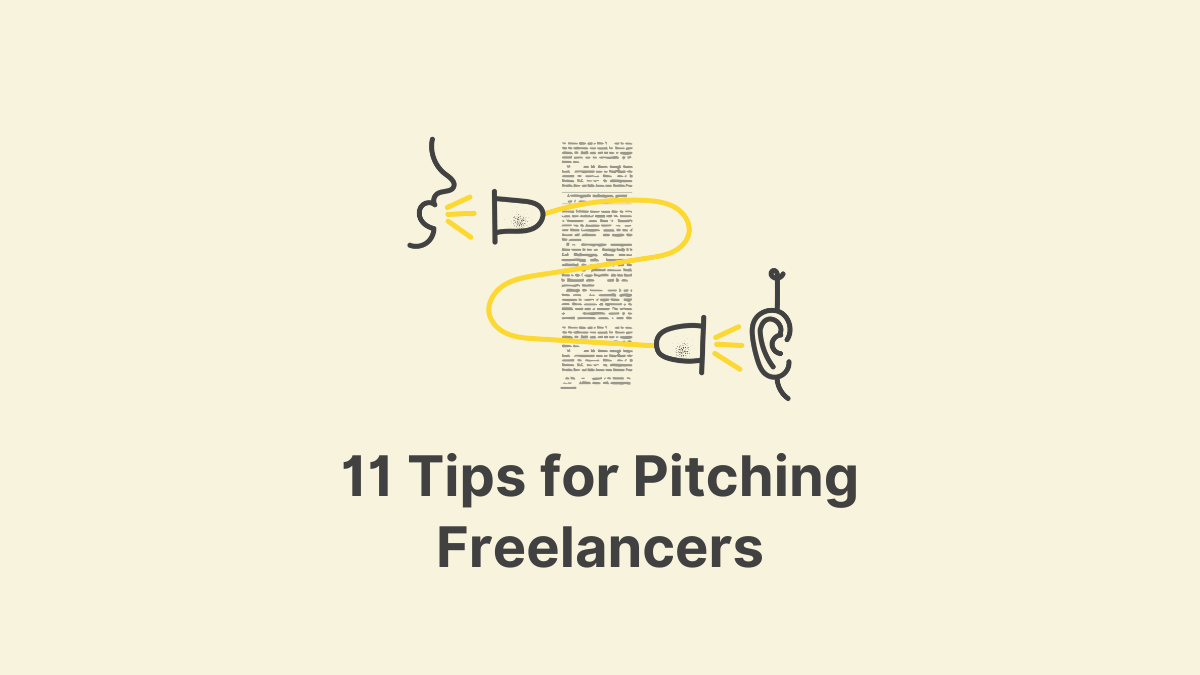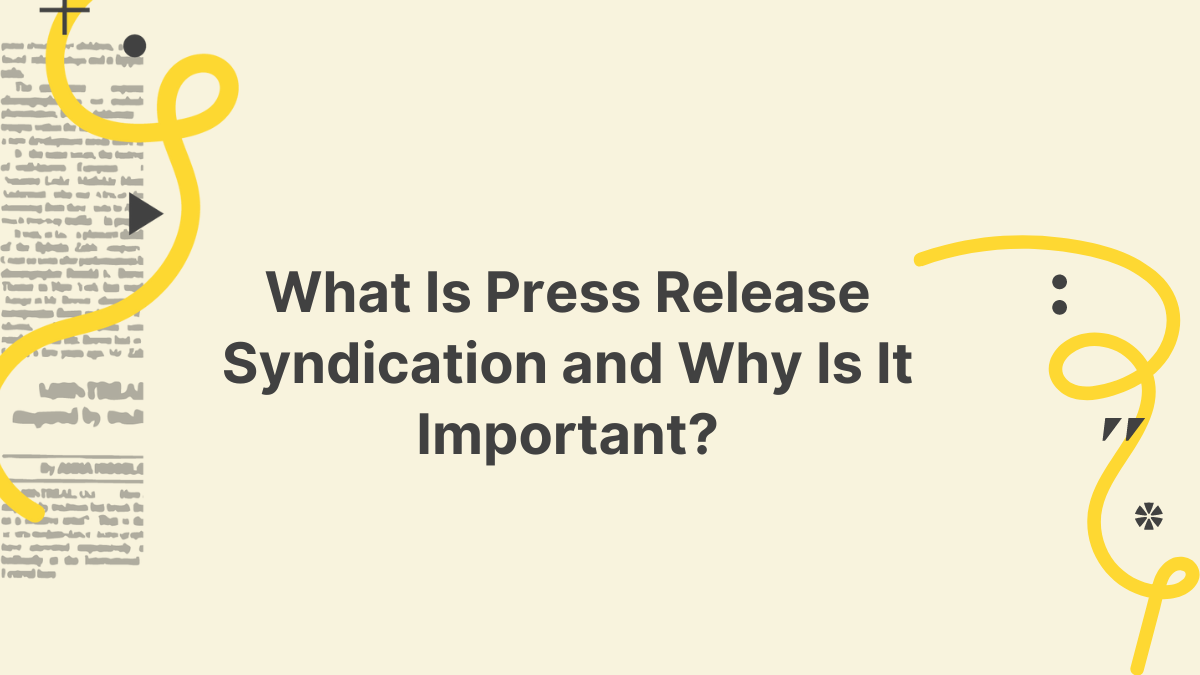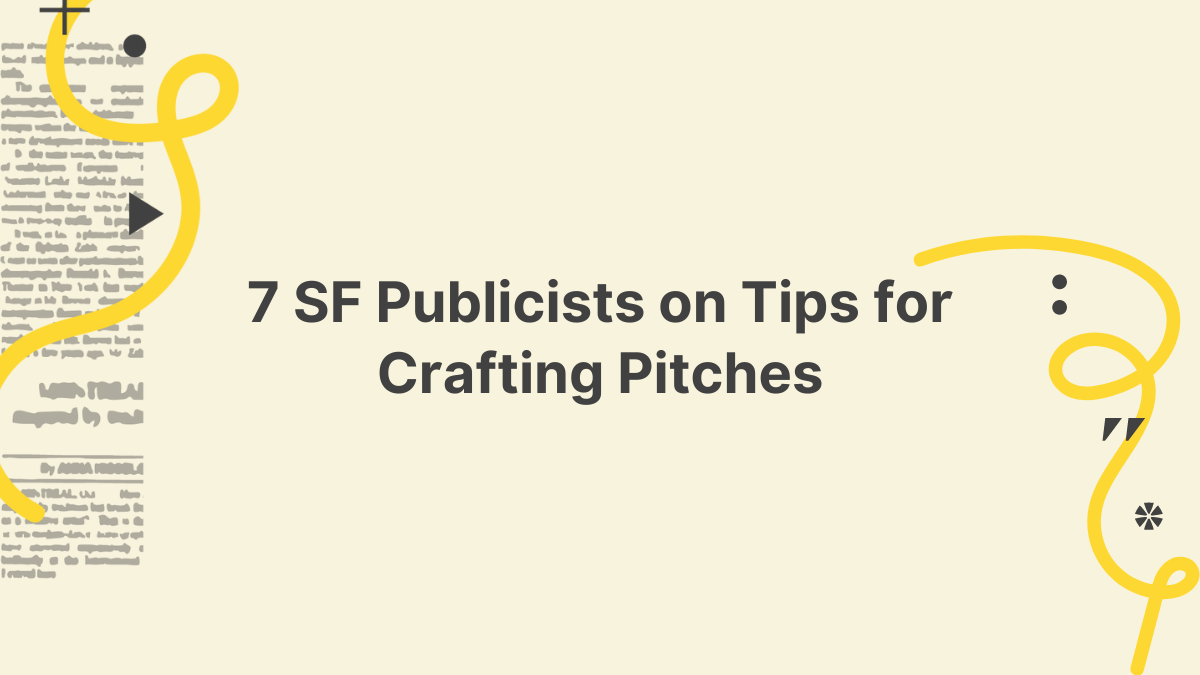Much like doing taxes or jumpstarting a car, some things just aren’t always taught in schools,...
×
5 Elements That Should be in Every Consumer Product Pitch
Standing out from the crowd is vital in a consumer media landscape that is flooded with product pitches. To capture a journalist's attention, your pitch should have five elements: accuracy, relevancy, transparency, efficiency, and credibility. Master all five, and your product will likely land in the spotlight.
Still trying to figure out where to start? Read how you should implement these five elements into every consumer product pitch based on insights we learned from our 2023 Coffee With A Journalist guests.
Accuracy: Do The Research
Before contacting a journalist, thoroughly research them and their work. It's crucial to align your product pitch with the journalist’s beat before hitting that 'send' button. While some journalists might redirect your pitch to someone else if it doesn’t fit their specialty, sending it to the wrong contact could lead to it being overlooked or deleted — particularly during busy periods.
In our conversation with Sara Spruch-Feiner, senior reporter at Glossy, she discussed the significance of investigating journalists before pitching and what kind of pitches she looks out for.
“It is surprising how many pitches I get that seemed to pitch me like I do write traditional consumer stories. So even though it's surprising to me that I have to say this, know who you're pitching. Know what they write about. Know that I write these sort of business light stories, that I write about influencer culture and social media and how brands are working within these new frameworks of new, whether it's TikTok or – we look at like when BeReal was really big last summer. Those are the things that I report on.”
Sending inaccurate pitches can often result in no response. Hannah Orenstein, Deputy Editor of Lifestyle and Wellness at Bustle, shared her experience receiving follow-ups from publicists whose pitches didn’t match the publication or its core audience.
“I do appreciate for somebody to follow up, if I haven't gotten back to them like within a reasonable time frame, if it's truly relevant. Because I get a lot of people who follow up for quite frankly products or people or whatever that just don't fit Bustle’s demo, whatsoever. So that's just my one note to publicists.”
Another step towards improving your accuracy in pitching products or a story involves staying up-to-date on a journalist’s role. Dani Kwateng, Executive Editor at Teen Vogue, pointed out that directly contacting editors might not be the optimal route to secure a story. Instead, focus on finding the reporters covering those specific industries.
“The thing about it is that I know what's going on from a top-level perspective. But I am not the culture editor, so I am not intensely thinking about how to make my section dope. I'm not thinking about what I want to do next year as a culture editor. I'm presenting it to me as the executive editor, but I am not. So if you want to get something that's culture-related or politics-related or style and beauty-related, talk to the person who's in it because I, as executive editor, don't know if they're already planning it. I can't say yes to your pitch if I don't know if they're working on the exact same story with another writer or another publicist.
So it's not even effective to really talk to me. I love building relationships to give advice. But, I
mean, in terms of getting into the industry or fostering relationships that will get you stories,
that's the editorial team. It’s not really me as much.”
Relevancy: Keep Up With Trends
Consumer publications strive to release stories and up-to-date gift guides with trends that resonate with their audience. PR pros should ensure their product pitch is relatable and relevant, making it easier for journalists to cover it or seamlessly incorporate it into their current stories.
Alexis Morillo, Lifestyle Editor at Bustle, emphasized the advantages of using trending topics in pitches. Beyond using trends in your subject line, Alexis highlighted the importance of finding opportunities to add value to a trendy conversation by offering relevant sources.
AM: “Another example from several months ago, but I do think it is hard when something's trending at the moment, catching the right time.”
BB: “Yes. It’s very difficult.”
AM: “That on the publicist’s side, it's hard of knowing, do we hop on it? Do we wait?
But this was related to a raw carrot salad that was going viral on TikTok.”
BB: “Oh, God, that thing. Yes.”
AM: “Yes. People were preaching the benefits. So I got the subject line on
#rawcarrotsaladtalk, TK company’s chief medical officer on what you need to know. I thought that was really great framing.”
BB: “Yes.”
AM: “It was trending. We were looking to write it up, but we also wanted to have a
professional give their input. That was, obviously, way easier than googling someone who could speak to something so specific. That actually was from a brand that was unrelated to carrots, unrelated to TikTok, so I thought that was just a really great way in.”
BB: “Yes. A little avant-garde, too.”
Alexis also elaborated that finding journalists and publications who continuously write stories related to the product you’re pitching can help increase the chances your pitch gets opened.
AM: “Yes, exactly. Then, another fun example was, “You're invited. XOXO, the brand,” live the Gossip Girl fantasy with.Then they kind of explained their pitch.”
BB: “Yes, I'd like to live the Gossip Girl. Yes, go ahead. Tell me more.”
AM: “Yes, exactly. So just from that, I wanted to click on it. Whether they did their
research or not, they did a good job because our entertainment team, our fashion team has
covered Gossip Girl from like a nostalgia angle. So it's definitely something that was on brand for us. I do think I mentioned before, but knowing that we are getting pitches from someone who has looked at Bustle and knows what we cover.
Of course, BDG has great brands under the parenting portfolios and the tech portfolios. But knowing that we are getting pitches that the publicists know are for the Bustle reader is definitely important. So I thought that was just a great example because we've covered Gossip Girl. Recently, we had a TikTok go viral about it. So I was like the timing could not be more perfect for that.”
Steer clear of excessively catchy or clichéd phrases like "brand new" or "first of its kind" when they don't apply. When pitching products that truly introduce novelty to their field, ensure a clear differentiator sets them apart from similar offerings. Zoë Weiner, Senior Beauty Editor at Well+Good, explained that using this kind of language can appear repetitive and insincere when a journalist is sorting through numerous product-related pitches.
ZW: “I think, I mean, first and foremost, it has to feel like a product that Well+Good
would cover. As I said, we don't – A lot of the pitches that I get are related to products, and then it's my job to kind of figure out like where the story is within those zillions of products.”
BB: “Because there are so many.”
ZW: “Yeah. I think products that really feel new and innovative and have
interesting science. I think if you have a product like that, and you can use the email to simplify the science for me to like take a quick look at the email and say, “Okay, this is something I want to learn more about,” I think that's great. I think products that really do feel real and different and revolutionary.
I have a big pet peeve of people putting in subject lines or an email copy like that something is the first or the best or the newest, when it is just not. I think no one's keeping track of those things. But that's another big no-no for me. If it's not the first or the newest, don’t say that.“
Transparency: Straightforward Subject Lines
The subject line is the first thing a journalist reads. When limited to just a few words, how do you prioritize what's crucial?
One approach is to craft a tailored headline inspired by the journalist's past articles and use it as the subject line. By doing so, you demonstrate you’ve researched their previous work, which shows the potential relevance of the product before the journalist opens the email.
Hannah Orenstein weighed in:
BB: “By the way, do you recommend that as a pitch strategy? Pitch the actual headline, whether you're a freelance writer or a publicist.”
HO: “A hundred percent.”
BB: “A hundred percent. That's good.”
HO: “Yes. Because just two things. Number one, it makes it really easy for me to understand what you're talking about, and it gives me sort of like a shortcut of like, okay, do you understand sort of like what headlines look like on our site and what a story should look like. But, also, it helps ensure that publicists or the writer are on the same page about how this is going to be framed or what we really want to highlight with this.”
Similarly, journalists need all the facts when sharing exclusives or embargoes. According to Zoë Weiner, it's best to share any important clarifiers directly in the subject line so that journalists don’t overlook specific deadlines and release dates.
“I need it to be really clear and really not misleading. So if Supergoop is launching a sunscreen, I want to know Supergoop is launching a sunscreen. Here's the embargo date. Then, especially because I keep everything so filed and so individualized, I really like to see “Like, okay, this is what this email is going to tell me,” if that makes sense. I don't need – I mean, every now and then, I appreciate something fun.
I got a really fun email last week from a publicist who represents a Japanese brand called
Shinko, and it was just like Japanese sleep tips that were inspired by ingredients from the thing. I actually thought that was interesting. Yeah. I think things like that where I'm like, “Oh, this is kind of a different in, and the subject line is telling me something a little bit different.” I like that too, but I don't need bells and whistles and curls. Keep it straightforward.”
Sara Spruch-Feiner recommended adding “exclusive” in the subject line as it can help alleviate a journalist’s frustration when they’re looking for a specific email later down the line.
“We don't typically cover things if we're not going to cover it right at the time that it’s launching. So, yes, like if it's an exclusive, like, yes, put that in the subject line. Tell me that kind of thing and make it so that I'm not digging in my inbox for it, for sure.”
PR pros can also enhance a subject line by including the word "reconnect" to leverage past relationships. It’s important to provide additional context, reminding the journalist of your past interactions, considering they may meet with hundreds of publicists. Even if your pitch doesn't exactly align with the journalist's current needs, ask them what they are working on or what would be helpful to them to foster the relationship even further. As shared by Hannah:
“But two strategies that I think publicists can borrow to other pitches. One, the person wrote the name of another website and said, “Reconnect/travel pitches.” I said, “Oh, reconnect. Okay, I'm going to open this because it's from somebody I know.” Again, to be honest, like I have no idea who this person is. But I opened it because they made me think that I knew who they were. I don't think you should lie. I think you should only use this if we truly did meet. Then you can say, “Oh, we met at such and such event in September,” or whatever.
But the pitch that she had was ultimately great, so that – actually, let me rephrase. It was not the right pitch, but she said, “What are you looking for?” Then I gave her a couple guidelines, and then she followed up with something that was really great.”
Efficiency: Provide Information Upfront
When reaching out to your journalist contacts, show them you’re prepared to supply all the necessary information for their story to bring them closer to crafting an excellent piece based on your pitch.
Create an organized pitch that emphasizes the essential details. Following your lead, bullet points are perfect for presenting smaller details like product descriptions, company specifics, and CEO information, and don’t forget to add photos (note that 80% of our 2023 guests favored attached images over Dropbox.). Allie Garfinkle, a senior tech reporter from Yahoo! News, shared how clear, comprehensive pitches are best when navigating chaotic inboxes.
“I really love when someone comes to me, ‘Hey, Allie. I read your story. I thought this was really cool. I actually do have a pitch for you,’ and gives me like really quickly everything that I would need to know, which brings me to the thing that is really important. Super long emails with giant blocks of text, I'm not going to deal with it. I will look at it. Unless it's someone I already know or, again, it's something that's finger to the pulse of the moment, exactly what I needed that given day because so much of my life is structured around breaking news.”
If you are sending your product for a review, Zoë Weiner emphasized why, with embargoes, it’s always better to receive products for testing in advance:
ZW: “I think embargoes are great because it means that we get the information about a product long before it's launched, which gives our team time to test it. Ideally, like we'll have four weeks to be able to test a product to really say, ‘Okay, it does what it says it does,’ or it doesn't.”
Unsure how to send multiple products from multiple clients for a gift guide? Alexis Morillo shared her tips:
“But I do think that, if someone has a bunch of clients, I prefer having all of it in one email. Like I said, I use that kind of as my Google search. So this guide in the subject line and then maybe inside the body of that, there's experience gifts, as well as hosting gifts, as well as wellness and beauty gifts. I can kind of use that as my guide rather than having five different emails of all the different categories from the same person. I think that's very helpful with gift guides.”
Credibility: Introduce Credible Sources
Outside sources and data add another layer of value to your pitch and product. By adding additional names or sources, you can effectively highlight the benefits and significance of your product, enhancing its credibility. Alexis Morillo noted that while having a celebrity endorsement is not always possible, it can be beneficial.
AM: “I also think it's nice and, obviously, this isn't always doable, but if there's something that has a buzzy celebrity component, such-and-such celebrity has used this, that's a great caption to use in a gift guide. So I think something like that.”
BB: “Oh, yes. Good point. Drop those celebrity names. Yes.”
AM: “Yes, exactly. Name drop.”
As you craft your next product pitch, remember that each element plays a crucial role in capturing a journalist's attention. Every pitch builds solid connections and can help your product reach larger audiences. To hear more from journalists, listen to our #CoffeeWithAJournalist podcast every Tuesday.
One of the most common challenges PR professionals face is knowing the right way to contact journalists. The majority of the discussion is typically around the first touchpoint — what is the right format, subject line, and content to have your message resonate with your audience? But when you finally decide who to target and what to say, you send your email, and then – nothing.
______
Want to land a placement in a top publication like Forbes? Try OnePitch for free, submit your client/brand information, get your curated media list, and start pitching directly on your OnePitch profile.
From an agency reporter to senior editors, learn how to pitch journalists on #CoffeeWithAJournalist. See more examples of pitches that landed on The TypeBar.
Do you have a pitch that landed your client exceptional coverage that you want to highlight? Email us at info@onepitch.co with your pitch and 3-5 reasons why you believe it worked.
Want more blogs like this?
Fill out the form below to subscribe to our newsletter and receive emails with the top blogs from The TypeBar!
Related Posts
Picture this scenario: your client is preparing to announce their Series C funding round. You start...
When crafting a pitch for media, where do you start? What’s your first thought? Maybe it’s, ‘Who...
Newsletter Form
Recent Posts
About Us
OnePitch was created by a handful of
tech-savvy publicists and journalists
who believe that the PR industry is
long overdue for some innovation.
We’re changing this with OnePitch.





